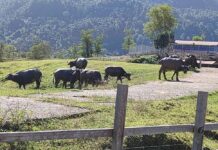
BY LAZIANA AHMAD
PLANT PATHOLOGISTS with the Malaysian Palm Oil Board (MPOB) have recently innovated a technology to accelerate the degradation of oil palm trunk and root mass especially those infected with the basal stem rot (BSR) disease. The technology was recently launched during the Transfer of Technology Seminar and Exhibition 2019.
The research team has formulated a Solid-State Cultivation (SSC) containing P. sanguineus to control Ganoderma infection. The formulation resulted in a higher decay rate of the healthy trunk, and more significantly in the trunk infected with Ganoderma.
Field trials reported that the efficacy of 500 g of SSC containing P. sanguineus in decaying diseased trunks was about 55% and 40% for the healthy trunk, after 10 months of application. SSC containing P. sanguineus is the potential alternative for a biotechnological approach to manage Ganoderma disease in the oil palm plantations in an eco-friendly manner.
Functioning as biological control agents, the SSC can accelerate the decaying process of stumps and trunks of oil palm especially those infected with Ganoderma spp. The technology is cost-effective and eco-friendly compared to other mitigation method to control Ganoderma infection, it helps to add nutrients to the soil, a practical Integrated Pests Management (IPM) strategy especially at replanting stage and most importantly, the technology offers a sustainable method to speed up waste recycling of root mass, stumps, and trunks of palm oil biomass.
The technology is worth RM 3.7 million at present, with an internal rate of return (IRR) at 36.25% and 5.5 years of investment recovery.
Identification of the bio-degrader.
The fungus Pycnoporus sanguineus is widely studied because of its ability to produce enzymes of industrial interest. The ability of this fungus to cause changes in wood composition and in the physical structure of pine trees was also proven in other research.
Categorised under the same group of white-rot fungi, P. sanguineus breaks down the wood using lignolytic enzymes that split chemical bonds of lignin- the stuff that makes wood tough- turning it into simple sugars and releasing carbon dioxide into the air.
P. sanguineus occur naturally on oil palm trunks and has shown the ability to act antagonistically against G. boninense.
In a study published in Forest Pathology in 2015, Dr Naidu’s team shed light on this fungal behavior revealing that P. sanguineus overgrew G. boninense by inhibiting the radial mycelial growth in vitro, believed to be through the production of volatile metabolites or antibiotics.
With the ability to produce a cocktail of enzymes involved in the degradation of plant tissues, P. sanguineus accelerates wood decaying process, especially on the infected oil palm with BSR disease, documented in her study published in Industrial Crops and Products later in 2017.
The team conducted wood decay experiments on isolates of P. sanguineus,















